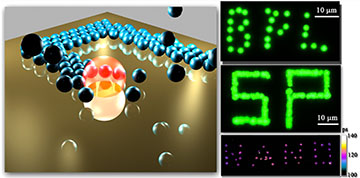Convective flow around a laser-induced microbubble (orange sphere) pulls in suspended colloidal nanoparticles (dark spheres), allowing the drawing of arbitrary patterns on the surface (examples in right column). [Image: Lin et al., Nano Lett., doi: 10.1021/acs.nanolett.5b04524] [Enlarge image]
A team of U.S. scientists has devised a new technique that uses laser-controlled microbubbles to draw patterns of chemically synthesized colloidal micro- and nanoparticles onto a flat substrate (Nano Lett., doi: 10.1021/acs.nanolett.5b04524). By reducing the cost and difficulty of patterning such particles, the approach—dubbed “bubble-pen lithography”—could, according to the researchers, find use in a range of functional devices, including “new functional hybrid materials and devices” integrating 2-D materials and quantum dots.
Interest in the possibilities of using pattered colloidal micro- and nanoparticles for functional devices has grown as the mainstream photolithography techniques used in semiconductor manufacture have nudged up against resolution limits. Precise patterning of colloidal particles on a solid-state substrate has proved a challenge, however, that most existing techniques haven’t quite nailed.
One obvious, versatile candidate for manipulating and ultimately patterning such particles is optical tweezers. But the high laser powers involved can damage the tiny particles en route to their final destination on the substrate.
The bubbles have it
A research team from the University of Texas, Austin, and Pennsylvania State University (USA), led by OSA Member Yuebing Zheng, hit upon the idea of using tiny laser-guided bubbles as a “pen tip” for patterning colloidal particles. They began by depositing a 4-nm-thick gold film atop a glass surface, to create a plasmonic substrate of gold “nanoislands.” The plasmonic substrate was then covered with a solution containing suspended colloidal particles—in this case, polystyrene beads of sub-micron size.
When a precise, focused laser at the plasmon resonance wavelength irradiates a spot on the submerged surface, the plasmonic enhancement creates a local “hot spot” that leads to the formation of bubbles as small as 1 micron in diameter (with the size of the bubble tunable by varying the laser power). When the bubble has formed, local convective circulation around it grabs at the colloidal particles and drags them toward the bubble-liquid interface—eventually pulling them to the substrate itself, where a combination of surface tension, gas pressure, and substrate adhesion immobilizes the particle on the substrate.
Arbitrary patterns
By using the laser to create a network of hot spots across the quasi-continuous surface, the system can be used, according to the scientists, to trap colloidal particles in arbitrary patterns across the substrate. And the near-field plasmonic enhancement means that the laser power—and thus, potentially, the cost of the technique—can be kept low. The video below shows the technique in action, used to draw a tiny pattern of the University of Texas “Longhorn” mascot:
While several experiments involved the use of polystyrene beads ranging from 540 to 60 nm in diameter, in one proof of concept the team used the technique to create a pattern of CdSe/ZnS core/shell quantum dots, each with a diameter of only 6 nm, across the surface. This result, according to the researchers, could point not just to a more flexible way to pattern colloidal particles generally, but to new classes of functional devices that “benefit from the synergistic integration of 0-D and 2-D materials.”

